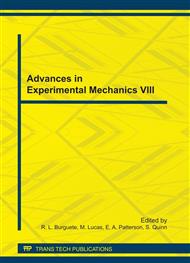[1]
Marty, P.N., N. Desai, and J. Andersson. NDT of kissing bond in aeronautical structures. in 16th World Conference on NDT. 2004. Montreal, Canada.
Google Scholar
[2]
Roach, D., K. Rackow, and R. Duvall. Innovative use of adhesive interface characteristics to nondestructivelyquantify the strength of bonded joints. in 10th European Conference on Non-Destructive Testing. 2010. Moscow.
Google Scholar
[3]
Yan, D., B.W. Drinkwater, and S.A. Neild, Measurement of the ultrasonic nonlinearity of kissing bonds in adhesive joints. NDT&E International, 2009. 42: pp.459-466.
DOI: 10.1016/j.ndteint.2009.02.002
Google Scholar
[4]
Brotherhood, C.J., B.W. Drinkwater, and F.J. Guild, The effect of compressive loading ont he ultrasonic detectability of kissing bonds in adhesive joints. Journal of Nondestructive Evaluation, 2002. 21(3): pp.95-104.
DOI: 10.1063/1.1373879
Google Scholar
[5]
Nagy, P.B., Ultrasonic detection of kissing bonds at adhesive interfaces. Journal of Adhesion Science and Technology, 1991. 5(8): pp.619-630.
DOI: 10.1163/156856191x00521
Google Scholar
[6]
Jiao, D. and J.L. Rose, An ultrasonic interface layer model for bond evaluation. Journal of Adhesion Science and Technology, 1991. 5(8): pp.631-646.
DOI: 10.1163/156856191x00530
Google Scholar
[7]
Maldague, X., Introduction to NDT by active infrared thermography, in Materials Evaluation. (2002).
Google Scholar
[8]
Maldague, X. and S. Marinetti, Pulse phase infrared thermography. Journal of Applied Physics, 1996. 79(5): pp.2694-2698.
DOI: 10.1063/1.362662
Google Scholar
[9]
Ibarra-Castanedo, C. and X. Maldague, Interactive methodology for optimized defect characterisation by quantitative pulsed phase thermography. Research in Nondestructive Evaluation, 2005. 16: pp.175-193.
DOI: 10.1080/09349840500351846
Google Scholar


